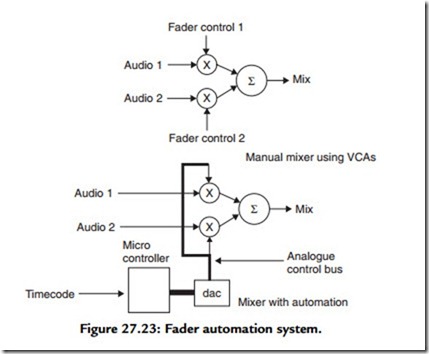Mixer Automation
Mixer automation consists (at its most basic level) of computer control over the individual channel faders during a mixdown. Even the most dexterous and clear thinking balance engineer obviously has problems when controlling perhaps as many as 24 or even 48 channel faders at once. For mixer automation to work, several things must happen. First, the controlling computer must know precisely which point in the song or piece has been reached in order that it can implement the appropriate fader movements. Second, the controlling computer must have, at its behest, hardware that is able to control the audio level on each mixer channel, swiftly and noiselessly. This last requirement is fulfilled a number of ways, but most often a voltage-controlled amplifier (VCA) is used.
A third requirement of a fader automation system is that the faders must be “readable” by the controlling computer so that the required fader movements can be implemented by the human operator and memorized by the computer for subsequent recall.
A complete fader automation system is shown in schematic form in Figure 27.23. Note that the fader does not pass the audio signal at all. Instead the fader simply acts as a potentiometer driven by a stabilized supply. The slider potential now acts as a control voltage, which could, in theory, be fed directly to the voltage-controlled amplifier, VCA1. But this would miss the point. By digitizing the control voltage, and making this value available to the microprocessor bus, the fader “position” can be stored for later recall. When this happens, the voltage (at the potentiometer slider) is recreated by means of a DAC and this is applied to the VCA, thereby reproducing the operator’s original intentions.
One disadvantage of this type of system is the lack of operator feedback once the fader operation is overridden by the action of the VCA; importantly, when in recall mode, the faders fail, by virtue of their physical position, to tell the operator (at a glance) the condition of any of the channels and their relative levels. Some automation systems attempt to emulate this important visual feedback by creating an iconic representation of the mixer on the computer screen. Some even allow these virtual faders to be moved,
on screen, by dragging them with a mouse. Another more drastic solution, and one that has many adherents on sound quality grounds alone, is to use motorized faders as part of the control system. In this case the faders act electrically as they do in a nonautomated mixer, carrying the audio signal itself. The control system loop is restricted to reading and “recreating” operator fader physical movements. Apart from providing unrivalled operator feedback (and the quite thrilling spectacle of banks of faders moving as if under the aegis of ghostly hands!), the advantage of this type of automation system is the lack of VCAs in the signal path. VCA circuits are necessarily complicated and their operation is beset with various deficiencies, mostly in the areas of insufficient dynamic range and control signal breakthrough. These considerations have kept motorized faders as favorites among the best mixer manufacturers, despite their obvious complexity and cost.
Time Code
Time code is the means by which an automation system is kept in step with the music recorded onto tape. Normally, a track of the multitrack tape is set aside from audio use and is devoted to recording a pseudo audio signal composed of a serial digital code.
